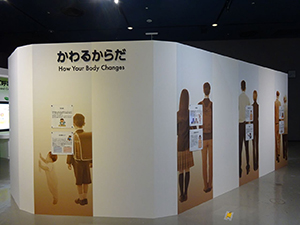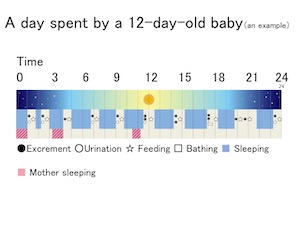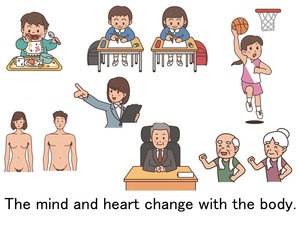Nagoya City Science Museum
TOP > Exhibition Guide > Keyword Search > Starting with "N" > newborn_period > How Your Body Changes
How Your Body Changes



Purpose of Exhibition
This exhibit explains changes in the human body at each stage of a person’s life. Displayed on the wall are nine large human illustrations (which depict the appearance of people in the individual stages) with text that describes milestone changes in a person’s life between the newborn period and puberty, and changes in adulthood. This exhibit divides a human life into six periods (stages of life) but consists of 10 sections because it has an extra section for puberty for each gender, adds one for the newborn period, and differentiates between infancy and the toddler period.
Additional Knowledge
[Newborn Period and Infancy]
People in these periods of life are babies. After coming out of their mothers’ bellies, babies learn to live in the outside world.
Babies within 28 days after birth are specifically called “newborn babies.” They exhibit “primitive reflexes” (reflexes are actions people take by nature without thinking), which are no longer exhibited after this period. Newborn babies spend most of the day sleeping. They have not yet established a daily rhythm. People do not sleep only at one time in a day until much later. Babies in this period repeat the cycle of sleep, feeding and excretion. After the newborn period comes infancy, a period up until around the age of one.
Newborn babies and infants are not just small. They need help from adults to control their body temperature, keep their bodies clean, and take in nourishment. In these periods, the body grows at the fastest rate in the person’s life. One-year-old babies weigh about three times as much and are about 1.5 times as tall as they were when they were born.
[Toddler and Preschool Periods]
Toddlers and preschoolers are no longer babies, but their bodies work quite differently from those of adults, indicating that that children are not “little adults” as some suggest.
Toddlers and preschoolers do not grow as fast as babies, but they exhibit growth in their internal organs as well as their height and weight. Also, their milk teeth start to be replaced by permanent teeth.
[School Age]
Children in this period go to elementary school. Through interactions with people around them and learning from them, school age children develop knowledge, skills, sociality, and the ability to think. Later years of elementary school age may sometimes overlap with puberty. In the upper grades of elementary school age, children’s bodies may become as big as adults’, but they still work differently from adults’ bodies.
[Puberty and Secondary Sex Characteristics]
From age 10 onward, people start to change from children to adults. Puberty is the second fastest body growth period in a person’s life after the newborn period and infancy. Remarkable changes in the body in puberty are called “secondary sex characteristics.”
Between babyhood and the lower grades of elementary school, male and female bodies do not look much different on the outside. The only noticeable difference between the genders is that boys have penises while girls do not. You cannot easily tell whether they are boys or girls when they are wearing underpants.
When children grow a little bit more and reach the age of 10 plus, they enter puberty. Other parts of their bodies also grow rapidly in a short time to resemble the bodies of adults, displaying secondary sex characteristics.
In puberty, the body grows in terms of height, chest size, and weight. Girls develop subcutaneous fat and become plumper with a rounded figure. Their pelvis (hip bone) develops, and their breasts enlarge. Boys develop broader shoulders, rapidly develop muscles to appear sturdier, and develop a prominent Adam’s apple, and their voice breaks. In this period, hair starts to grow in specific parts of the body (the armpits and near the sex organs). Boys also have thicker hair on their feet and face (beard growth). Some children start to develop acne.
These rapid changes start in girls’ bodies one or two years earlier than in boys’, so girls tend to be taller than boys in the same grade. Since different parts of the body grow bigger at different timings, their build changes in various ways—it is slender at one time and rounded at another.
In addition to the build, the body undergoes remarkable changes inside, including the production of hormones.
Girls have their first period (also called the “menarche”), while boys have their first ejaculation (also called the “spermarche”). In this way, children’s bodies develop to prepare them for reproducing the next generation.
Puberty is also a period when the way in which the mind and heart work changes significantly, including ways of feeling and thinking.
[Adolescence]
In adolescence, how the mind and heart work changes significantly, including ways of feeling and thinking. Adolescents have mature bodies and have reached the age for raising the next generation (the reproductive age). Body functions are at the peak performance in a person’s life, and many parts of the body work better.
[Middle Age]
Like adolescence, middle age is a time for raising children, but middle-aged people have more social responsibilities than adolescents.
Compared to during adolescence, some body functions diminish in middle age. Both men and women in middle age undergo hormonal changes called the “menopause.” Women are more likely to experience health disturbance due to rapid changes caused by the end of their menstrual cycles.
[Old Age]
Old people are no longer in the reproductive age, but many of them have time to live better. More people in this period suffer from disease, but they typically accept their disease and cope with it well.
While motor and respiratory functions and eyesight diminish, the functions of some digestive organs and the ability to solve problems do not decline. Some people do not change much in personality, too. How and when changes come vary from person to person.
A study shows that some blood constituents and intelligence do not undergo much change with age.
Many Japanese people today live a long healthy life, and Japan has one of the highest life expectancies in the world. Women’s life expectancy is longer than men’s, and women live several years longer than men.
Article by Tomoko Horiuchi, curator
